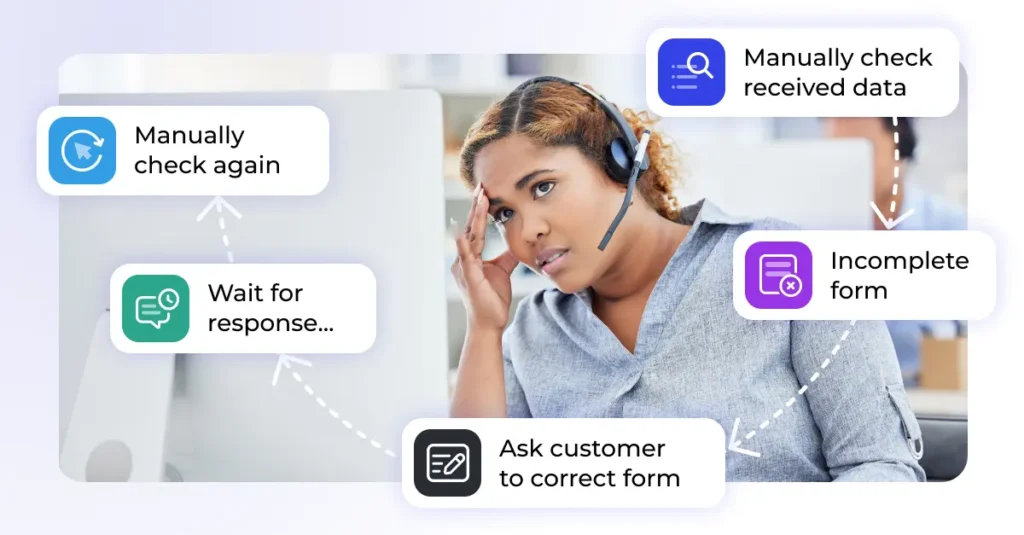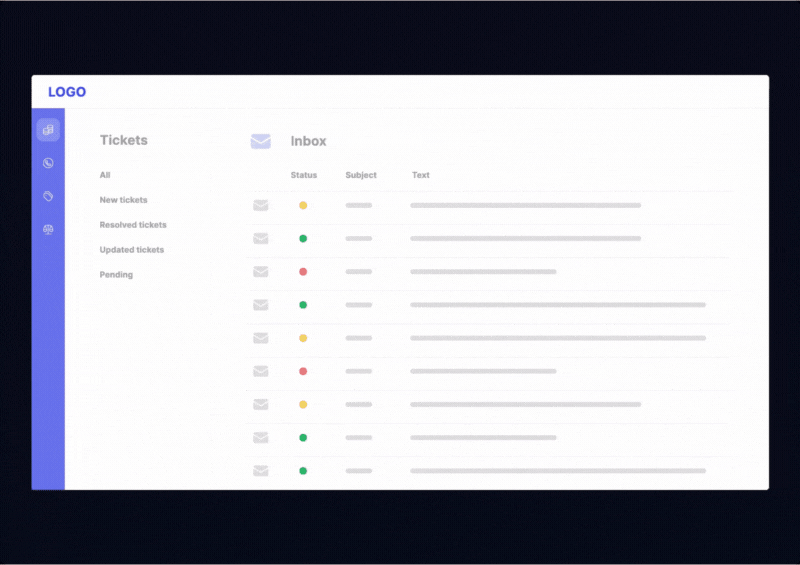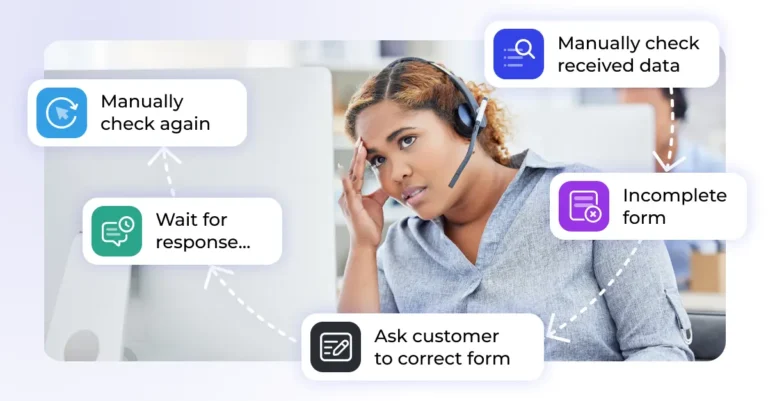Data Validation tools that work across Excel, scans, and forms
Automatically validate incoming data to ensure it’s complete, correct, and ready for processing — no manual checks needed. Knots uses AI-powered automation for data validation across formats like Excel, PDFs, scans, emails, and web forms, before it enters your systems.
Some of our customers
What is data validation?
Data validation is the process of checking incoming data to ensure it is complete, accurate, consistent, and properly formatted before it enters a business system or workflow. This prevents errors, saves time, and ensures data quality across tools and teams.
It applies to everything from web forms and PDFs to Excel files and scanned documents — and is absolutely indispensable for every business that relies on data.
Whether you’re processing return forms, validating stock updates, or approving customer applications: without accurate data, nothing flows.

Types of Data Validation (with real-world examples)
Validating your data ensures incoming information is usable, structured, and reliable. It can take many forms depending on the data source and business requirements. Below are common types of ensuring all your information is correct — often combined into one automated workflow:
- Format validation – Ensures that data follows a required pattern (e.g. dates in YYYY-MM-DD, valid phone numbers, or postal codes).
- Presence check – Confirms that required fields such as name, email, or ID number are not left blank.
- Range check – Verifies that values fall within acceptable limits, such as age, quantity, or transaction amount.
- Cross-field validation – Compares values across fields for logical consistency (e.g. end date must come after start date).
- Reference validation – Checks values against approved lists or lookup tables (e.g. product IDs, customer SKUs, valid currencies).
- File type validation – Accepts only specific file formats like PDF, Excel, or DOCX; flags others as invalid.
- Schema validation – Ensures that the structure of submitted data matches a defined schema (e.g. JSON structure for APIs).
Why data validation matters for your business
Without validating data, you notice missing or faulty information too late — leading to miscalculations, false claims, and other errors that result in losses, unhappy customers, and disrupted processes.
In many companies, data validation is still a manual, tedious, and error-prone task. Teams open documents, check content manually, and type values into internal systems. If anything’s missing, back-and-forth with the sender begins — often by email.
Let us show you how to automate these processes — and make them faster, cheaper, and more accurate.
✅ Reduce manual work
✅ Increase speed and accuracy
✅ Avoid delays and frustration
✅ Fit into your existing stack — no dev work
✅ Secure, compliant, and scalable
Learn more in our blog post on automating data validation workflows.
Reduce manual work
Increase speed and accuracy
Avoid delays + frustration
No dev work: Fit into your systems
Secure, compliant, and scalable
How Knots handles data validation — across formats and systems

Data validation powered by automation and AI
There isn’t a single off-the-shelf validation tool that handles all systems, files, and formats. That’s why Knots uses flexible middleware and automation workflows tailored to your needs:
- Document and format recognition
Knows what kind of file it is — Excel, scan, DOCX, PDF — and how to process it. - Data extraction and enrichment
Extracts values from structured or unstructured content and transforms them into usable, clean text. - Business rule validation
Checks formatting, logic, dependencies — whatever your workflow requires. - Automated feedback
Missing or invalid data triggers a personalized message. When new info arrives, validation restarts. - Final structured output
Once all checks are passed, validated data enters your system — or is passed to your team for action.
Validating data: Manual vs. automated
Data validation can be performed manually or automatically — but only one approach scales.
✍️ Validating data manually
- Files are opened and read one by one.
- Team members check fields and copy values manually.
- Errors or missing data require follow-up emails.
- The process is slow, error-prone, and doesn’t scale.
⚙️ Validating data automatically
- Documents are instantly recognized and parsed.
- Fields and formats are checked in real time.
- Missing or invalid data triggers automatic replies.
- Updates resume the validation process automatically.
Result: Clean, complete, and correct data — ready to use with no manual effort.
✅ Common data validation use cases
- ✔️ Customer onboarding via forms, scans, or emails
- ✔️ Order, return, and delivery forms in e-commerce
- ✔️ Insurance and healthcare claim processing
- ✔️ Identity checks and compliance documentation
- ✔️ Internal data workflows with ERP/CRM integrations
❌ What happens when you skip validation?
- 🚫 Delayed fulfillment and customer responses
- 🚫 Billing errors and failed reports
- 🚫 Lost sales and compliance risks
- 🚫 Unnecessary support overhead
- 🚫 Damaged customer trust

Secure, compliant, and built for enterprise use
We work with sensitive data and complex systems every day. That’s why security and scalability are at the core of every Knots solution.
We never store your customer data — and process only what’s needed.



Data validation powered by automation + AI
Check our video walkthrough: How health insurance claims get validated using Knots automation. Examples of supported platforms:
CRM systems: Salesforce, HubSpot, custom builds
File uploads: Google Drive, SharePoint, Dropbox
Support: Zendesk, JIRA, ServiceNow
Internal databases and APIs
Custom portals and web forms
Document formats: Excel, Google Sheets, CSV, DOCX, PDFs — even handwritten scans
More real-world data validation examples across industries
❓ Incomplete documents submitted during compensation requests
✔️ Flight numbers, IBANs, dates checked automatically. Gaps trigger smart replies.
❓CMS-1500 forms contain errors or missing CPT codes.
✔️Forms are scanned and checked before issues affect billing.
❓ Missing IDs or unreadable barcodes on shipment documents
✔️ Issues are flagged instantly; partners are notified automatically.
❓ Users upload incomplete or expired ID documents.
✔️Type and expiration checked; upload request triggered if needed — no agent required.

Let’s fix your data today!
Every dashboard, decision, and automation depends on accurate, complete, and validated data.
With Knots, validation happens before your team gets involved — so your people focus on value, not formatting.
✅ Free audit
✅ No strings attached
✅ Results in days, not weeks
Frequently asked questions about data validation
What is data validation used for?
Why is data validation important?
Without validation, incorrect or incomplete data enters your systems and causes problems: wrong decisions, failed reports, compliance issues, or unnecessary manual work. Validating data upfront means fewer disruptions, faster processes, and higher customer trust.
What types of data can be validated?
Knots can validate all kinds of input data, including:
- Excel, CSV, Google Sheets
- PDFs, Word, scanned documents
- Web forms and file uploads
- API payloads (JSON, XML)
- Emails, images, handwriting (via OCR)
Each input is handled according to its structure and validation rules.
What types of data validation rules are supported?
Can I automate feedback if the data is invalid?
Yes. If fields are missing, incorrect, or inconsistent, Knots can trigger:
- Personalized messages via email or chat
- Automated replies in Zendesk, Salesforce, etc.
- API callbacks or webhook responses
- Reminders and escalation flows
How does automated text extraction speed up response times?
What’s the difference between data validation and data cleaning?
Can Knots handle handwritten or scanned forms?
Can Knots handle handwritten or scanned forms?
Yes. We process handwritten and mixed-format documents using advanced extraction and analysis methods. This includes:
- Scanned forms and paper applications
- PDFs with a mix of typed and handwritten fields
- Files containing checkboxes, signatures, or free-text notes
Accuracy depends on file quality and layout — and fallback actions can be defined if extraction confidence is low.
👉 Want to go deeper? Learn more about document text extraction.
Blog
The latest news about Zendesk automation, customer support solutions, automation trends and more



